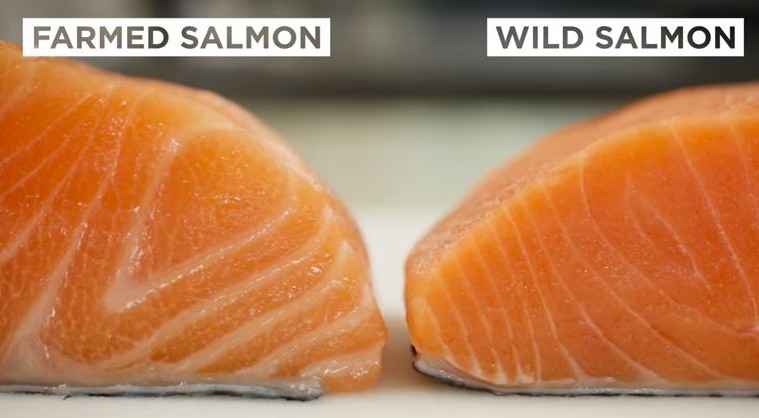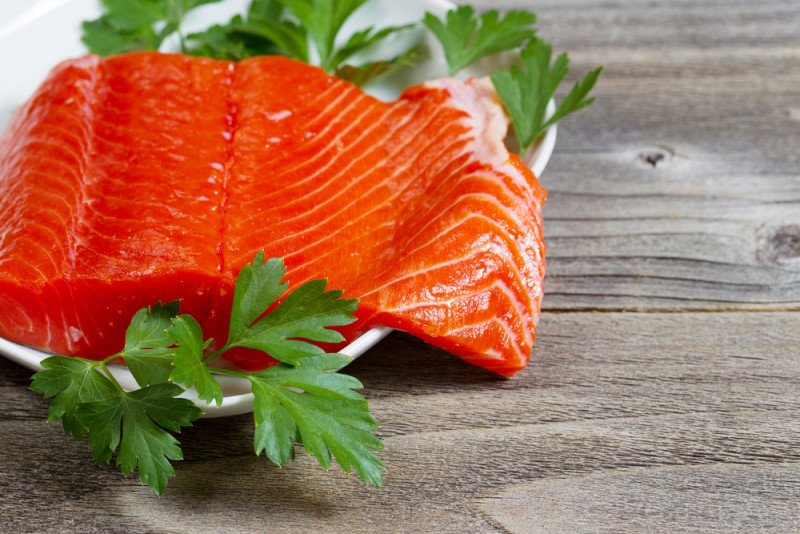
You’ve probably heard about some of the incredible health benefits of salmon. It is a source of high-quality protein as well as vitamins and minerals, including potassium and vitamin B12, and it contains Omega-3 fatty acids, which contribute to healthy brain function along with a healthy heart and joints.
People across the world are eating salmon in a ton of different ways — baking it, roasting it, grilling it, smoking it, and eating it raw — which is safe to do, if you are buying the right salmon.
The flavor and fattiness of salmon, along with its nutrient content, depend on where it came from. If you have a taste for fish, you’ll want to make sure you are buying clean, healthy salmon, and not the farmed category.
The color is a great indication of whether or not you are buying real salmon. The color of a wild-caught salmon is a robust red, which is exactly what salmon should look like. The color of farmed salmon is very light and pale in color as if the fish was sick. Astaxanthin is a bright red molecule found in algae, plankton, and krill, and it gives salmon its color. This molecule is extremely beneficial to the human body. It is an antioxidant and an anti-inflammatory, it improves blood flow, and it enhances mitochondrial energy production.

This bright red-orange color is a good indicator of wild-caught salmon. Farmed salmon will be a pale pink color.
Wild salmon get plenty of this molecule from their diets while farmed salmon eat food pellets that don’t contain natural astaxanthin, so farmers add in their own synthetic version, which is most commonly derived from coal. The fish feed used by farmers also includes fish meal and fish oils that are at risk of dioxin and mercury contamination. Some farmers have tried to replace fish meal with soy and corn protein and vegetable oil, but salmon are not meant to eat soy and corn, so meat quality decreases and antibiotics are needed to keep them healthy. Trace amounts of these antibiotics can make it into the food we eat while vegetable oils reduce Omega-3 fat content and can introduce mold toxins into salmon. You do not want to eat that!
The FDA and the EPA have been studying mercury contamination in fish, and wild-caught salmon is at a very low risk of mercury contamination. Fresh salmon is considered safe for pregnant women to eat. Check out the video below to make sure you are cooking your salmon to the right temperature!
Here are some of the most nutritious types of wild salmon to look for:
Sockeye Salmon – This type of salmon contains the most astaxanthin, cholesterol, and vitamin D because sockeyes keep a diet of almost exclusively plankton. They are tough to farm due to their unusual eating habits, so this type of salmon is almost always wild. Sockeye salmon is high in Omega-3s and has a strong flavor, so it is great smoked.
Chinook (King) Salmon – This type of salmon contains almost twice as many omega-3’s than any other salmon. They live in cold, deep water and the extra omega-3’s stay liquid in their system to keep them warm. King salmon are the largest salmon in the world and can grow to well over 100 pounds. They are very versatile from a cooking standpoint, but grilling, slow barbecuing or smoking are popular choices.
Pacific Coho Salmon – Coho has the third-highest fat content of salmon, along with a great amount of vitamin D and Omega-3s. It has a very delicate flavor, so some prefer to poach it to keep it moist, or use it for sushi.
Wild salmon is worth every penny. There are so many cooking options, and buying it wild ensures that you are getting all of the amazing nutritious benefits it has to offer. Check out this super-simple way to season and cook your salmon.

No comments:
Post a Comment